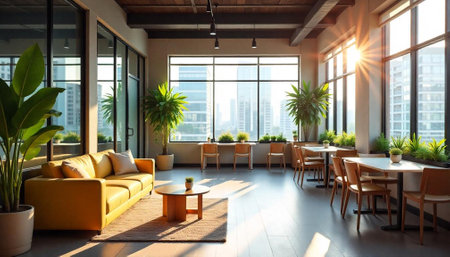Introduction: The Urban Green Revolution
Across the UK, city living is experiencing a profound shift as urban dwellers increasingly seek out homes that are both sustainable and in harmony with their surroundings. This burgeoning appetite for greener lifestyles is reshaping how we think about housing in bustling metropolises like London, Manchester, and Birmingham. With space at a premium and environmental concerns rising up the agenda, the concept of urban eco-homes has emerged as a compelling solution—one that maximises green spaces even amidst the dense fabric of city life. Local authorities are responding in kind; initiatives such as London’s “Urban Greening Factor” and Manchester’s “Green and Blue Infrastructure Strategy” reflect a policy-driven push to integrate nature into cityscapes. These governmental efforts dovetail with grassroots enthusiasm for allotments, rooftop gardens, and communal green areas, signalling a wider cultural movement towards sustainability. In this context, urban eco-homes are no longer a niche aspiration but an essential response to the challenges—and opportunities—of contemporary UK city living.
2. Balancing Heritage and Innovation in UK City Homes
The quest to maximise green space within Britain’s urban eco-homes is as much a cultural journey as it is an architectural one. British cities are renowned for their rich historic fabric, from Victorian terraces in Manchester to Georgian crescents in Bath. The integration of modern, eco-friendly features into these treasured buildings presents a unique challenge: how can we honour the past while embracing the future? This balancing act is shaped not only by aesthetic considerations but also by stringent conservation regulations designed to safeguard local character.
Architectural Challenges and Approaches
Urban eco-home projects must navigate a maze of planning permissions, listed building restrictions, and community expectations. While new-builds can freely incorporate solar panels, green roofs, or triple-glazing, retrofitting such features into period properties requires inventive solutions. Architects often work closely with local authorities and conservation officers to identify materials and technologies that blend seamlessly with original façades and structures. For example, slim-profile double glazing can be used in sash windows, while living walls might be installed in discreet courtyards to preserve street views.
Cultural Sensitivities and Local Identity
Britain’s urban communities place immense value on continuity of place and identity. Eco-innovations must not erode the unique visual language of neighbourhoods—be it London’s Edwardian streetscapes or Edinburgh’s sandstone tenements. In practice, this means that every intervention—whether rainwater harvesting systems or permeable paving—must be tailored to the locality. Community engagement often plays a vital role, ensuring residents have a say in how their shared heritage evolves.
Heritage vs. Innovation: A Comparative Overview
| Aspect | Heritage Focus | Eco-Innovation Focus | Integrated Approach |
|---|---|---|---|
| Building Materials | Traditional brick, slate, timber | Recycled or sustainable materials | Lime-based renders with recycled insulation |
| Windows & Doors | Sash or casement styles; single glazing | Triple glazing; passive ventilation | Slimline double-glazing within original frames |
| Energy Systems | Conventional boilers; open fires | Heat pumps; solar PV panels | Ground-source heat pump concealed in garden areas |
| External Spaces | Paved yards; small gardens; railings | Green roofs; wildlife habitats; rain gardens | Courtyard living walls; pollinator-friendly planting schemes |
| Regulatory Considerations | Listed Building Consent required for changes | Permitted Development for most technologies in new builds | Bespoke consent negotiated for sensitive eco-upgrades |
This delicate interplay between heritage and innovation defines the evolution of eco-homes across UK cities. Success lies not in imposing futuristic aesthetics but in weaving sustainability into the existing urban tapestry—creating homes that are both forward-thinking and deeply rooted in place.
![]()
3. Creative Use of Limited Space: Rooftop and Vertical Gardens
Urban eco-homes across the UK are reimagining what it means to live sustainably in the heart of bustling cities, where space is at a premium. Instead of traditional gardens, British architects and residents are turning their gaze upwards and outwards, making inventive use of rooftops, walls, and communal spaces.
Rooftop Allotments: Cultivating Above the Skyline
One standout approach is the development of rooftop allotments—a nod to Britain’s cherished tradition of allotment gardening, now transplanted to city heights. In London’s Southwark area, for example, community housing projects have transformed once-bare roofs into thriving plots brimming with herbs, vegetables, and pollinator-friendly blooms. Residents not only benefit from homegrown produce but also enjoy a unique sense of community fostered above the city streets.
Living Walls: Greening the Vertical Plane
The living wall—or ‘green wall’—has become an iconic symbol of urban ecological innovation in places like Manchester’s city centre. These installations use a matrix of native plants to cloak building exteriors in lush foliage. Beyond their striking visual appeal, living walls help regulate building temperatures, filter urban air pollution, and provide vital habitats for insects and birds. The Moss Side Eco-Homes project is a prime example: its south-facing vertical garden draws local attention while quietly improving residents’ quality of life.
Communal Courtyards: Shared Spaces with a Green Heart
Another emerging trend is the revival of communal courtyards within new eco-home developments. Rather than private gardens, these shared spaces maximise greenery through edible planting schemes and wildflower meadows. At the Elephant Park regeneration scheme in London, communal courtyards serve as social hubs where neighbours can gather among fruit trees and raised beds—proving that green space can be both functional and inclusive.
A Blueprint for Urban Resilience
The creative adaptation of limited urban space through rooftop allotments, living walls, and communal courtyards demonstrates how British ingenuity is setting new standards for sustainable city living. Real-life examples from London to Manchester illustrate that even in the densest environments, there are myriad opportunities to cultivate nature—and community—in unexpected places.
4. Local Materials and Low-impact Living
One of the most compelling aspects of urban eco-homes in the UK is their dedication to utilising locally sourced materials, which not only reduces transportation emissions but also supports regional economies and craftspeople. In the heart of cities like Manchester, Bristol, and London, there is a growing preference for brick and timber reclaimed from nearby demolition sites, as well as natural insulation such as sheep’s wool or hemp grown in British fields. This focus on local provenance fosters a sense of place while ensuring that new builds harmonise with their historic surroundings.
Energy-efficient Systems: The Urban Advantage
Modern eco-homes are designed to minimise energy consumption through the use of advanced systems tailored for city living. Triple-glazed windows, air-source heat pumps, and green roofs are now common features in many UK urban developments. These technologies not only reduce carbon footprints but also insulate residents from city noise and fluctuating weather conditions—a real boon during those blustery British winters.
Rainwater Harvesting: Resourcefulness in Action
With water security becoming an increasing concern in densely populated areas, rainwater harvesting systems are gaining traction among urban dwellers. These setups collect rainfall from rooftops and store it for non-potable uses such as flushing loos, washing cars, or watering rooftop gardens. The table below illustrates typical applications:
| Application | Potential Water Savings per Year (UK average home) |
|---|---|
| Toilet Flushing | Up to 50% |
| Garden/Rooftop Irrigation | Up to 40% |
| Laundry Use | Up to 20% |
Cottage Industry Revival: Eco-friendly Home Goods
The resurgence of Britain’s cottage industries has dovetailed neatly with the urban eco-home movement. Artisans across the country are crafting everything from recycled glass tiles in Yorkshire to upcycled furniture in the Midlands, all tailored for compact city flats and terrace houses. These bespoke products not only lend character to urban spaces but also champion circular economy principles—reducing waste, supporting small-scale producers, and encouraging mindful consumption. For many city dwellers, choosing these locally made goods is about more than aesthetics; it’s a conscious step towards low-impact living that feels distinctly British.
5. Community-led Eco Projects and Shared Green Spaces
Across the UK, a quiet revolution is unfolding in city neighbourhoods: grassroots eco-initiatives are taking root, reimagining urban living through collaboration and local ingenuity. At the heart of these movements lies a distinctly British sense of community spirit—one that values shared responsibility, cooperation, and collective wellbeing. Urban community gardens, for example, have sprung up from Edinburgh’s tenement courtyards to London’s railway arches, transforming overlooked spaces into vibrant hubs for growing vegetables, herbs, and pollinator-friendly flowers. These gardens do more than provide fresh produce; they foster intergenerational connections, encourage outdoor activity, and create sanctuaries of calm amid city bustle.
Shared Tool Libraries: A Modern Take on Resourcefulness
Another innovation gaining traction is the rise of shared tool libraries. Echoing the ethos of “make do and mend”, these initiatives enable residents to borrow gardening tools, DIY equipment, or even bike repair kits—reducing waste and promoting skill-sharing across communities. Such schemes not only save money but also strengthen neighbourly ties, as people collaborate on projects ranging from window box planting to urban beekeeping.
Neighbourhood Composting Schemes: Closing the Loop
In tandem with gardening projects, neighbourhood composting schemes are helping urban dwellers close the sustainability loop. Local councils and volunteer groups have set up communal compost bins in parks and estates, inviting households to divert kitchen scraps from landfill and create nutrient-rich soil for community beds. The process demystifies composting while reinforcing a sense of ownership over local green spaces—a subtle yet powerful nod to Britain’s tradition of allotment gardening and self-sufficiency.
Celebrating Collective Action
These bottom-up projects reveal how British cities can nurture both ecological resilience and social cohesion. By embracing shared green spaces and community-led eco-hubs, urbanites are not just maximising greenery—they’re cultivating a renewed sense of belonging rooted in collective action. In a landscape where public space can feel scarce, these initiatives offer hope: proof that city living needn’t come at the expense of connection to nature or neighbour.
6. Navigating Obstacles: Policy, Costs, and Planning Permissions
Transforming a traditional British home into an urban eco-haven is no mean feat. Homeowners must wade through a uniquely British tangle of policies, costs, and permissions that shape every green ambition.
Council Permissions and Local Authority Hurdles
Securing council approval is often the first major hurdle. Urban properties, particularly those in conservation areas or near heritage sites, are subject to stringent local authority rules. Planning permissions for green roofs, solar panels, or even sustainable extensions can be a lengthy process, with councils prioritising the protection of neighbourhood character over innovative eco-friendly upgrades.
Listed Buildings: The Challenge of Heritage
Britain’s rich architectural legacy means many city dwellings are listed buildings. Owners of such properties face stricter controls on modifications; even minor changes intended to boost energy efficiency—like double glazing or wall insulation—can require specialist approvals. Balancing the demands of heritage preservation with sustainability goals is a perennial urban challenge.
Navigating Costs and Government Grants
The financial side cannot be ignored. While eco-home upgrades often promise long-term savings and increased property value, the upfront costs can be significant. Fortunately, UK residents may access government grants such as the Green Homes Grant (now closed but indicative of periodic incentives), Energy Company Obligation (ECO) schemes, or localised council funding for specific measures like heat pumps or insulation. However, these grants come with eligibility criteria and application complexities that require careful navigation.
Building Knowledge and Community Support
Many successful eco-home projects in UK cities rely not just on individual determination but also on tapping into local networks—whether neighbourhood forums, online communities, or support from forward-thinking architects familiar with British planning intricacies. Sharing experiences helps demystify the process and encourages more homeowners to take the leap towards greener living.
7. A Greener Urban Future: Vision and Cultural Shifts
The rise of urban eco-homes in UK cities signals more than just a shift in architectural preference—it reflects a profound cultural transformation within British society. As green spaces are woven into the urban fabric, the traditional image of city living is being reimagined. Where once dense rows of Victorian terraces or post-war estates dominated, we now see a growing tapestry of rooftop gardens, community allotments, and innovative green façades. This movement is not merely about aesthetics or environmental responsibility; it is changing what it means to be British in the 21st century.
Redefining National Identity Through Housing
Historically, British identity has been closely tied to notions of home—whether the suburban semi, the countryside cottage, or the urban flat. Eco-homes infuse this narrative with new values: stewardship, innovation, and collective action for sustainability. For many Britons, embracing eco-friendly urban living is becoming a point of pride, aligning national heritage with forward-thinking environmentalism. The homes themselves serve as daily reminders that progress and tradition can coexist harmoniously.
Cultural Adaptation in Everyday Life
On a day-to-day level, the integration of green spaces into residential life encourages new rituals and connections among city dwellers. Shared gardens foster neighbourly bonds reminiscent of village greens; edible landscapes inspire a return to local food traditions; and outdoor communal areas offer inclusive spaces for all generations. These shifts gently challenge the stereotype of urban anonymity, nurturing a sense of community rooted in shared purpose and place.
Looking Ahead: From Trend to Mainstream
As urban eco-homes become more widespread, they have the potential to redefine mainstream expectations for housing across the UK. This evolution is supported by government policy, grassroots activism, and shifting public attitudes towards climate resilience and wellbeing. The hope is that what starts as a pioneering movement will soon become the default standard—where every new development prioritises biodiversity, energy efficiency, and social cohesion.
In essence, urban eco-homes are not just physical structures but catalysts for cultural renewal. They invite Britons to imagine a future where thriving cities and flourishing nature are not at odds but inextricably linked—a vision where everyday urban life embodies both modern British ingenuity and an enduring respect for the land beneath our feet.


